Civil Air Patrol






Open Mic night, every 3rd Wed at 1900
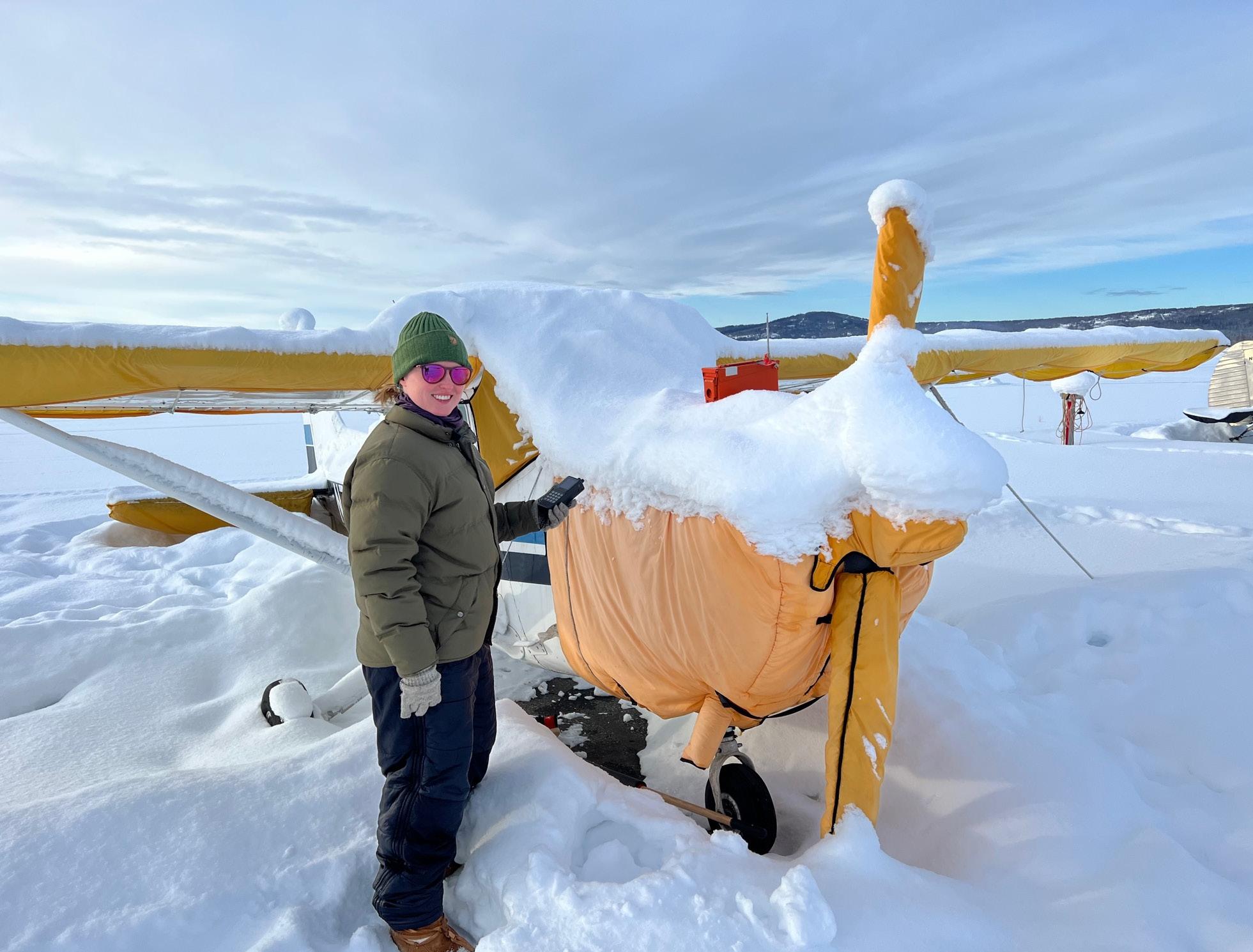

March 2023
Col. McClure Wing Commander
In Washington, D.C. on 3/2/23 at CAP National Legislative Day, are L to R
Capt Reux Stearns (AK Legislative Liaison)
Col Kevin McClure (AK Wing Commander)
C/CMSgt Connor Burnside, Senator Lisa Murkowski

C/CMSgt CJ Ancheta
Col Tim Verrett (AK Legislative Liaison)
2 CAP AKWG
CAP AKWG 3 Index Important announcements Wing Available Positions Wing Staff Abbrevations Cadet Program Aerospace Education Communication Emergency Services Publics Affairs Achievements Miracle on Buffalo Pass - Article Next Month Preview Tail Section 4 4-5 6 7 8-17 18-19 20-21 22-31 32 33 34-35 37 38
Important announcements
Save the Date
2023 AKWG Annual Conference, Anchorage, October 6-8
AKWG Encampment Registration Opens
When: Wednesday, Mar 15, 2023
Description: 2023 AKWG Summer Encampment Registration opens. More info here: https://akwg.cap.gov/encampment/2023
Raptor Day--Cadet Tour of Raptor Ops at JBER
When: Saturday, Apr 1, 2023
Description: CAP-USAF has arranged for CAP cadets & accompanying SMs to tour the F-22 Raptor Operations at JBER. POC CAP Capt Karen Padgett
(karen.padgett@akwg.cap.gov) & CAP-USAF Maj Christopher Sharon
WING VACANCIES
Commander AK-93 Lake Hood
• Leads senior members and cadets in accomplishing the CAP ES, AE and cadet programs.
• Provides leadership and oversight to staff in executing weekly meetings.
• Responsible for compliance with CAP policy, guidance and operating procedures.
• Reports to the AKWG Commander.
Character Development Instructor
• The Character Development Instructors are part of the CAP Chaplain Corps but have different qualifications and responsibilities than chaplains.
• Complete training requirements for character development instructors.
• Present character development lessons for cadets in the absence of a Chaplain.
Assistant Public Affairs Officer - Public Relations, Digital Engagement and Creative Services
• Works with Public Affairs Officer to provide oversight across AKWG units and staff to ensure a CAP-compliant and active social media presence.
4 CAP AKWG
Development Officer
• Directs and coordinates overall planning activities.
• Develop plans for and monitor the overall implementation of special projects/programs as directed by commander/headquarters.
• Plan and coordinate region, wing or group conferences.
• Interpret laws, policy statements, directives, regulations, and other communications received from higher headquarters and integrate their requirements and guidance into plans and programs.
• Assist in the development of operational plans and programs when requested.
Director of Aerospace Education
• Implement aerospace education policy and advise their commander on the status of AE programs.
• Recruit, train and assist subordinate AE personnel in accomplishing a successful AE mission.
• Establish and review budget requirements.
• Develop AE Plan of Action (Wing level only).
Wing Command NCO
• Participate in the decision-making process, as appropriate, on technical, operational and organizational issues.
• Advise the Wing Commander for dress and personal appearance items affecting CAP members and specifically NCOs.
• Serve as a representative of the Wing Commander.
• Serves on award and recognition selection committees.
Wing NCO Advisor
• Participate in the decision-making process, as appropriate, on technical, operational and organizational issues.
• Work closely with their wing’s command NCO.
• Perform other duties as directed by the wing commander.
• Encourage NCO mentorship of cadets and junior officer CAP members.
FOR FULL JOB DESCRIPTION AND DUTIES, REFER TO CAPP 30-1
CAP AKWG 5
JOIN US
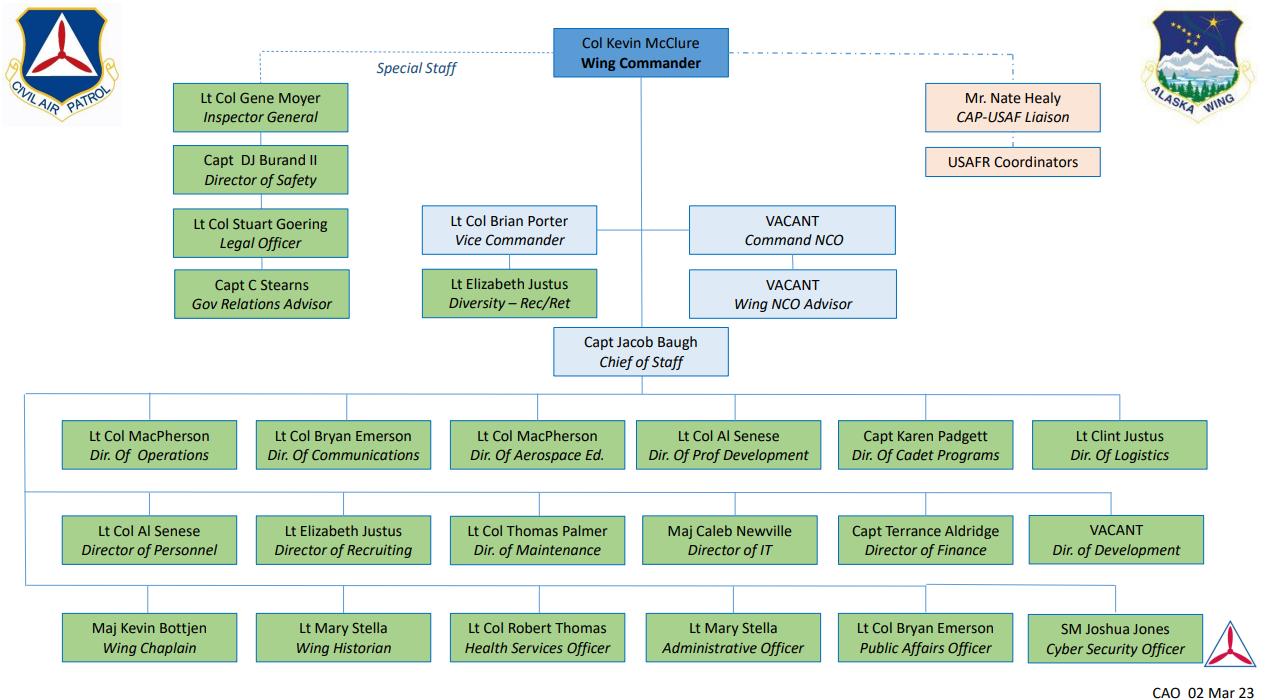
6 CAP AKWG
Within the Civil Air Patrol we use several abbreviations.
Let's review them:
CAP AKWG 7 Commander .................................................... CC Vice Commander ........................................... CV Deputy Commander .................................... CD Deputy Commander for Cadets ...............CDC Deputy Commander for Seniors ..... ........CDS Chief Operating Officer (NHQ only) ... ....COO Chief of Staff .....................................................CS Deputy Chief of Staff ....................... ............DCS Command Chief Master Sgt........................CCC Executive Officer ............................................XO First Sergeant ................................................. CCF (Cadet or Composite Squadrons only) Administration ................................................DA Aerospace Education .............................. .....AE Cadet Programs ............................................. CP Chaplain.............................................................HC Communications (Director) .......................DC e-Learning (NHQ only) .................................EL Finance ..............................................................FM Wing Financial Analysts............................... FMA General Counsel (NHQ only) .................... .GC Government Relations Advisor..................GR Government Relations (NHQ only) .........GVR Health Services ...............................................HS Historian .......................................................... HO Human Resources (NHQ only) ................HR Information Technology.............................IT Inspector General ....................................... IG Legal Officer ................................................. JA Logistics ......................................................... LG A/C Maintenance Officer ......................... LGM Supply Officer .............................................. LGS Transportation Officer .............................. LGT National Operations Center..................... NOC Operations .................................................... DO Communications (NHQ only).................. DOK Counterdrug ................................................ DOC Emergency Services ...................................DOS Homeland Security .................................... DOH Operations Training.................................... DOT Standardization & Evaluation ................. DOV Personnel ....................................................... DP Plans and Programs .................................... XP Professional Development ....................... PD Public Affairs .................................................. PA Safety ................................................................SE Wing Administrator (NHQ employee) ..WA
Let’s see what our cadets and seniors were doing during the month of February and what our squadrons want to tell us



They had a spot uniform inspection done. They also had a PFT which focused on form.

8 CAP AKWG
Cadet 1st Lt Benedict Inspecting Birchwood Squadron Uniform
Photograph taken by Cadet Chief Master Sergeant Edwards
The color guard season is ramping up for the Cadets of Kodiak.
Kenai Cadets Highlights
March 2023
Every Monday 6:30 to 8:30 Kenai Cadets and Seniors make Aerospace, Leadership, Safety and Character Development Presentations. Cadets learn a lot and new cadets learn how to present important information. Cadets also participated in a Space Launch at the Challenger Center in Kenai. Half of the cadets were on Ground Control and others were being launched. The two teams switched places half way through the launch. The experience was very exciting and successful.
Orientation Flights continue to occur. Thank goodness for great weather.
All cadets are working hard, setting a good example in our community and supporting each other in practicing the Core Values.
Please WELCOME TO our five new cadets
They are:
Cadet Bjorn David
Cadet Clayton Greenwald
Cadet Hugh Traugott
Cadet Gianna Traugott
Cadet Eliran Weisser
We are proud of them.
Three of these new cadets were able to participate in a SAR and received flights.
CAP AKWG 9
Back
C/SrAm. Moises
C/2Lt. Simeonoff
C/CMSgt. Ancheta
Middle
C/SrAm. Eaker
C/TSgt. Lorch
Front
C/SrAm. Burnside
Uniform inspection has (left to right)


C/CMSgt. Ancheta
C/CMSgt. Long
C/CMSgt. Burnside
C/TSgt. Lorch
C/SrAm. Burnside
C/SrAm. Eaker
C/SrAm. Leinburger
The girls disguising themselves as boys while waiting to present colors.

C/SrAm. Burnside
C/SrAm. Eaker
C/TSgt. Lorch
10 CAP AKWG
Polaris-Lake Hood Composite Squadron
The Polaris-Lake Hood Composite Squadron kicked off with an ES meeting on February 7th, 2023. The cadets participated in a line search activity led by C/CMSgt Wegemer and a radio communications class led by Col. Porter and C/Maj. Porter. A confusing but funny conversation ensued before both separate classes realized they were using the same channel at the same time.
Lake Hood Squadron celebrated their 5th birthday with a "Cappy Valentines" celebration and kickoff of the Rocketry AE meetings. 2d Lt Moon presented on the 4 Pioneers of Rocketry. The presentation was followed by a hands-on rocket building activity: cadets had the chance to build both rubber band-powered rockets and air-powered rockets. It can be safely said that this was the most engaging AE activity that our unit has seen in a while. Blasting rockets against the ceiling of the hangar while fantasizing about national defense was an experience to remember.
The meeting on the 21st of February was the first Lake Hood-Polaris PT meeting held on JBER. CAP vans provided transport from Merrill Field to the base. The location was not the only special aspect of this meeting, however--it was a joint meeting with Arcturus Squadron. PT tests and stretching started off the meeting, and our cadets had the chance to bond with Arcturus cadets through the fun activities afterward.
An Open House hosting seven prospective cadets preceded our monthly Character Development/Blues/Drill and Ceremonies meeting. There were several new faces, and as prospective cadets watched the awards ceremony, many of them no doubt saw themselves receiving their wings once they joined. Chief speeches and a CAC report were followed by flight time and the aforementioned awards ceremony. Our unit has been doing exceptionally well on recruiting by inviting friends to the Open House.
The Cadet Competition Team has practiced eight times this month, and are preparing to take on the challenge of National Competition. Good Luck to all Cadet Competition Team members. May your dedication be fittingly rewarded.
Many CAP activities have taken place this month, but undoubtedly the highlight was the Winter Bivouac, officially known as Operation Denali. Throughout the two-night adventure, the cadets learned ES skills and completed GTM tasks for their respective badges. The exercise tested the ES capability of our unit, as all food and other gear had to be carried on one’s person. Sleeping in one’s shelter on the second night was *highly* encouraged, and though it was cold, one could not ask for a more hands-on emergency exercise.
CAP AKWG 11
Days are getting longer and SAREX, cadet activities, and flight training are in full swing at the 9th squadron. Commander Maj. Jim Low is an outstanding leader and supports safe and effective operations at the Fairbanks 9th squadron.



O-rides took place in Delta and Fairbanks, G1000 and ELT search and location classes were offered and two new pilots got certified.

12 CAP AKWG
Alaska Wing Director of D.E.I. has a winter coat drive year round, and have added food and other items for adults and kids in our community. We call it Acts of Kindness.


Region Cadet Leadership School. Cadets keep talking about their experience. They learned a lot and are sharing their excitement with others to encourage them to enjoy the same opportunity

CAP AKWG 13
Southeast Composite Squadron
The Southeast Composite Squadron held their second Alaska Coastal Training Academy (ACTA) in February! ACTA is a three day long activity that allows the cadets in the Southeast Composite Squadron, and other cadets that wish to participate, to receive training in a focused field (such as emergency services, NCOS, and rocketry) and come together as a team to build stronger bonds. Southeast Composite Squadron is located in three different locations- Juneau, Sitka, and Hoonah Alaska. Because of this, it isn’t very often that the cadets throughout the squadron get to meet and interact with each other. Last August, the squadron held its first Alaska Coastal Training Academy, and because it was extremely successful and beneficial, Juneau hosted the second (of many to come) just last February. Cadets received training in expanding emergency service knowledge and character development. They got to enjoy team building activities (such as a game/ movie night) as they bonded as a squadron. Cadets were trained how to work together to carry a litter as well as other survival skills involving first aid and cold weather protection. The Squadron Commander, Maj Lisa Marx, taught a class on the importance of temperance, especially when a part of a ground team mission. The cadets also were able to participate in their first ground team training mission, in search of an ELT. After training and classes, the cadets had a blast playing in the deep Alaskan snow, enjoying frozen yogurt at a local shop, watching a movie, and participating in various team building activities together throughout the weekend. By the end of the activity, the group consensus was that the second ACTA was a tremendous success and all cadets involved had an amazing time working, training, learning, and playing together throughout the program. They look forward to the next one to come! If you are interested in participating in the next ACTA or just want to hear more about it, email ak022-acta@akwg.cap.gov for more information!
Written by: C/TSgt Alexis L. Juergens
14 CAP AKWG
Group picture taken outside of the Southeast Composite Squadron’s hangar in Juneau, AK during February’s Alaska Coastal Training Academy. From Left to Right: SM Chad Coppin, Capt Karl Marx, C/Amn Nathaniel Thorstienson, C/ A1C Joseph Anders, C/CMSgt Ava Coppin, C/Amn Fredrik Thorstienson, C/TSgt Gunner Lotz, C/A1C Jeremiah Helms, C/2d Lt Elijah Goins, C/Capt Thomas Clifton, C/Amn Asher Regier, C/TSgt Alexis Juergens, C/A1C Daniel Degner, C/ SrA Daniel Juergens, Maj Andrew Coyendall, and SM Ethan Hubbard.
C/A1C Daniel Degner blowing a whistle during a training session on whistle signals. Picture taken by C/TSgt Alexis Juergens, outside of the Southeast Composite Squadron’s hangar in Juneau, AK during February’s Alaska Coastal Training Academy.

Cadets from the Southeast Composite Squadron participate in the litter carry during a training session led by C/CMS Ava Coppin (front right) and C/TSgt Gunner Lotz (front left). Picture taken in the Squadron’s hangar in Juneau, AK. Cadets in the picture, from front to back, left to right: C/ TSgt Gunner Lotz, C/Amn Fredrik Thorstienson, C/ A1C Jeremiah Helms, C/A1C Joseph Anders (in litter), C/CMSgt Ava Coppin, C/Amn Asher Regier, C/ A1C Daniel Degner. Picture taken by C/SrA Daniel Juergens.

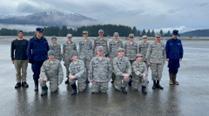
Cadets from the Southeast Composite Squadron crossing the Brotherhood Bridge in Juneau, AK during an emergency services training mission during the Alaska Coastal Training Academy. Cadets Present: C/Amn Nathaniel Thorstienson, C/Amn Fredrik Thorstienson, C/TSgt Gunner Lotz, C/A1C Jeremiah Helms, C/2d Lt Elijah Goins, C/Capt Thomas Clifton, C/ Amn Asher Regier, C/A1C Daniel Degner, C/SrA Daniel Juergens.
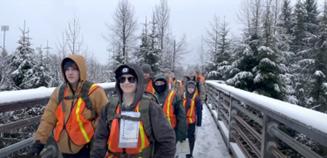
CAP AKWG 15
SM Alyssa Rittel is the newest VFR CAP pilot at the Fairbanks 9th Squadron. She works toward becoming an airline pilot and got admitted to the Horizon program. She is also a mom, takes care of her family, and 16 dogs. Yes, she is a dog musher and an excellent pilot.


16 CAP AKWG


CAP AKWG 17
The photos are from a recent cross country trip to Talkeetna in the C172 G1000
Do you know the STEM program offered by the Civil Air Patrol

Let take a look
America, historically the most innovative country in the world, is in dire need of a next generation workforce of STEM experts. Yet, America's youth are lagging in STEM interest, competence, and career pursuit. Immediate attention is needed in schools and youth evelopment organizations to provide rigorous and relevant opportunities for experiential STEM learning. The April 2014 Air Force STEM Workforce Strategy, Bright Horizons 2.0, addresses the roadmap ahead.
CAP is addressing this national issue by collaborative initiatives with organizations, such as the Air Force STEM Outreach Office, to provide STEM opportunities for cadets and K-12.
How to Participate:
A. Members must be:
CAP AEOs
CAP Assistant AEOs
Squadron Commanders
DAEs
Wing Commanders
DCS/AEs
CAP Educator Members
B. Members must:
Complete the online application form and submit
Administer the Pre-test and gather results
Spend at least 6 hours with the STEM Kit
Administer the Post-test and gather results
Complete the online evaluation form and submit
18 CAP AKWG
Birchwood cadets are in the middle of a Great Start program and starting a STEM program using indoor

Safety precautions should be practiced at all times with all CAP materials and programs.

CAP AKWG 19
Photograph taken by Cadet Chief Master Sergeant Edwards
Do you like communications?
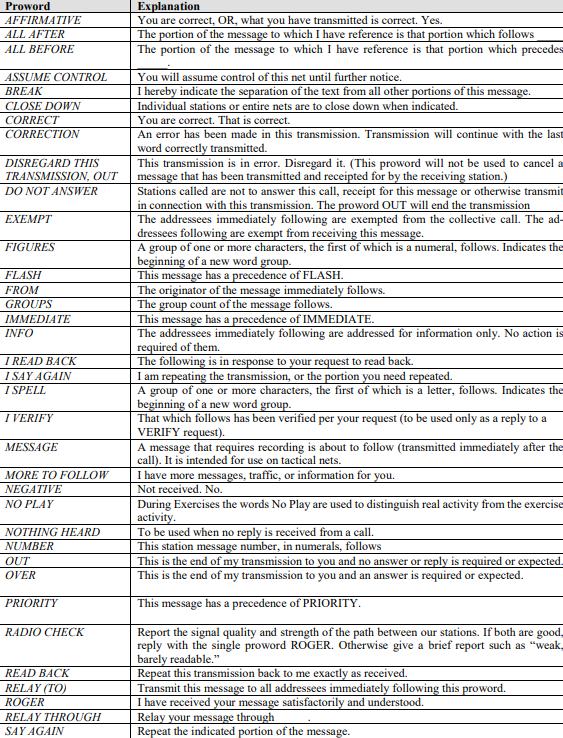
Let's see the proword that we use to communicate and its explanation

20 CAP AKWG
Pro Tip #1 For Radio Operators

When checking into a net, use your call sign only, or call sign followed by “Over.” It is not necessary to say “No traffic.”

On a net with a handful of people, it doesn’t matter very much if you state the obvious or say more than you need to say. But if you allow yourself to fall into the habit of doing those things, you will be a problem on a bigger, busier net. When you say more than you need to, you are making it much harder for other people to check in and be heard.
Let’s use our relatively small nets to develop and maintain good habits.
CAP AKWG 21
2023 AKWG Winter Bivouac

17-19 Feb 23 2QTR SAREX & Survival
Alaska Wing Aircrew and Ground Teams Survive and Thrive In Arctic Conditions!
-2023 Alaska Wing Summer Encampment Public Affairs Staff Writers
On 17 February 2023, Alaska Wing aircrew and ground teams across the state gathered to refresh and build on their survival skills, communications and SAR/DR capabilities, from the panhandle rainforests to the bitter interior. 8 units (3 more than last year) involved in the planning, staging and execution of a 2-day event focused on winter operations, survival, Ground Team, Aircrew and ICS Staff training. Southeast and South-Central components were cadet-planned (Cadets Benedict, Nielsen, Mellerstig, Clifton and Coppin) and cadetled. Hawk Mountain Ranger School syllabi were used in addition to the NESA Task Guide, ensuring all 24 participants were proficient with Ranger Third Class tasks including feldcraft, firecraft, mobility and survival task areas.

22 CAP AKWG
Maj Low and the Fairbanks team deployed 2 aircraft from Fairbanks to Delta to fly Cadet O-flights and then on to Tok to conduct flight training with Capt Harry White. Maj Low conducted ELT tracking training and G1000 academics. C/Capt Clifton accomplished 3 ground sorties IVO Juneau mission base, refreshing and building upon previous MTT training Chief Martin, AK-17, qualified as GTL and is prepared to lead training in home unit upon coordination with AKWG/ES and AK-17/CC C/MSgt Taya Nielsen completed MSA training; WMIRS, WX and mission briefing tasks, accomplished in real-time with ground teams.
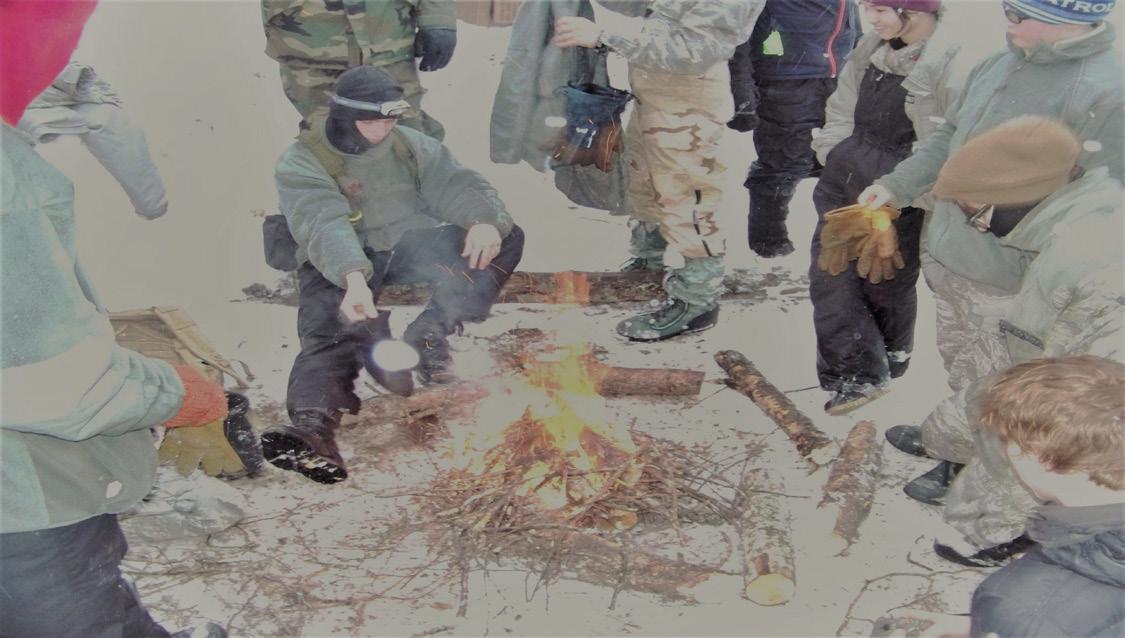

Lt Col Bryan Emerson ran the comm exercise (and re-hacked CUL tasks) from his MatSu location, interfacing with Lt Rice in Craig, Colonel Porter at PABV using READY OP, GoToMeeting, VHF simplex, VHF ALMR and cell phones 12 ICUT practical tests administered; ICUT qualifications completed for all 3 CAP-USAF members (Lt Col Healy, Maj DeFoor and Chief Wake) participated and provided hands-on training and support for participating cadet and senior members.
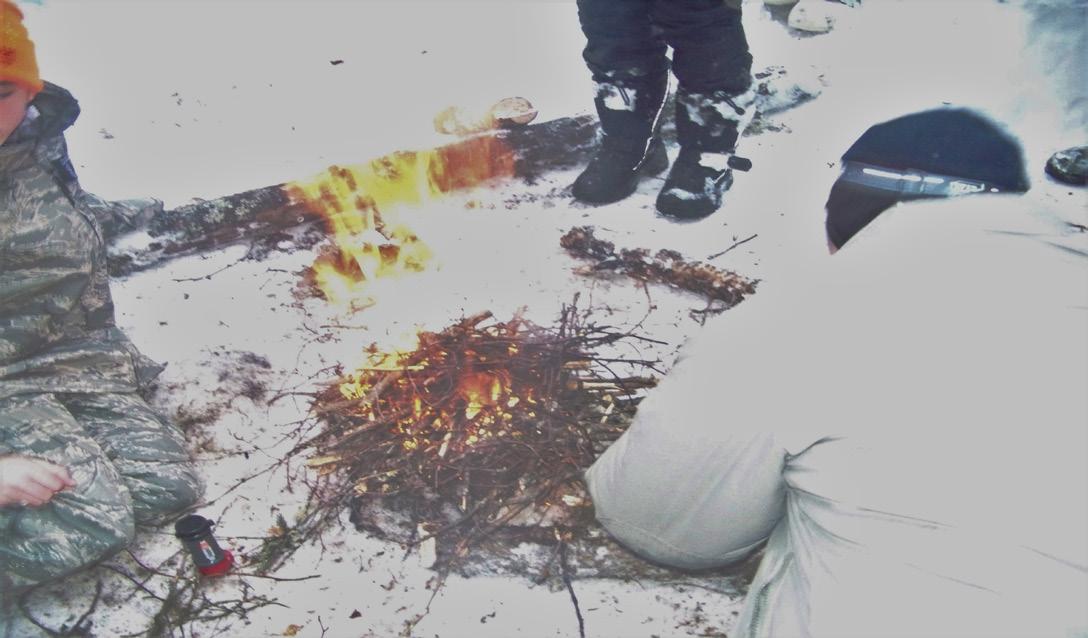
CAP AKWG 23
C/2ndLt Benedict teaching the cadets how to make a fire. Photagrapher C/SMSgt Parker
The Cadet watching C/Maj Porter burn his boots Photagrapher C/SMSgt Parker
LESSONS LEARNED:
* Shelter: 4 feet of snow takes a while to dig out, but makes for a cozy "foxhole" and A-frame natural shelters

* Communications: AK VHF Motorola radios work well in the cold weather with new batteries holding a charge for over 24 hours with light traffic. Simplex worked we in moderate cover over 2 miles. ALMR programming needs to be updated on Base Stations as well as hand-held Motorola/EF Johnson radios.
* Personal gear: Members should keep track of personal gear and avoid the "hard sale" at the end of SAREX/loss of equipment.
*Ground to air signaling: Vector aircraft with a clear offset to ensure pilot or scanner can maintain visual through the pass.
* Aircrew and GTM training: Take every opportunity to train during meetings and weekend activities to ensure that SAREX activities can focus on repetition and expanding basic skills.
* Expect a wing-led opportunity to take on these challenges next winter.
24 CAP AKWG
Overall, the intrepid members of Alaska Wing demonstrated once again that they stand ready to execute our Search and Rescue/Disaster Relief missions on land and in the air, and our members are ready to survive and thrive in the arctic!

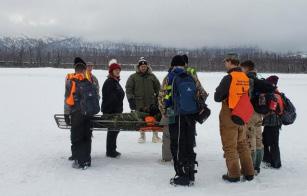



CAP AKWG 25
Weather phenomena observed during a SAREX flight along the Alaska Range.

Altocumulus Standing Lenticular (ACSL) or Altocumulus Standing Lenticularis clouds are associated with high wind speeds. Standing waves in the atmosphere develop when relatively stable, fast moving air is forced up over a topographic barrier like the Alaska Range that is oriented more or less perpendicular to the direction from which the upperlevel wind is blowing.

26 CAP AKWG
Severe turbulence and strong up and downdrafts are associated with mountain waves. Caution pilots.



CAP AKWG 27
Precise knowledge of terrain is vital in aviation, especially for low-flying routes and maneuvers (see terrain collision avoidance) and airport altitudes. Terrain will also affect range and performance of radars and terrestrial radio navigation systems.
Let's take a look at the different types of terrain
The five major terrain features are: Hill, Ridge, Valley, Saddle, and Depression.

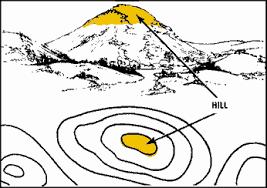

Valley- Terrain goes up in three directions, and down in one, ussually a river or a stream flow in it. reasonably level ground bordered on the sides by higher ground. A valley may or may not contain a stream course. A valley generally has maneuver room within its confines. Contour lines indicating a valley are U-shaped and tend to parallel a stream before crossing it. The course of the contour line crossing the stream always points upstream.

28 CAP AKWG
Hill- A point or small area of high ground. From the hilltop, terrainslopes down in all directions. On the map a hill is depicted by contour lines forming concentric circles.
Ridge- A line of high ground with height variations along it's crest. The terrain slopes down in three directions an up in one.


Saddle- A low point or hole in the ground. Terrain goes up in all directions. Hash marks indicate decreasing elevation.

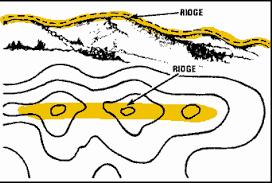
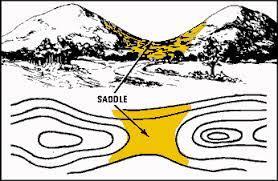
Depression- A low point or hole in the ground. Terrain goes up in all directions. Hash marks indicate decreasing elevation.
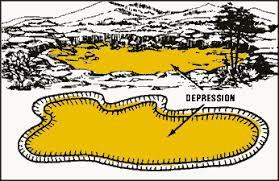
CAP AKWG 29
The three minor terrain features are: Draw, Spur and Cliff

Draw-similar to a valley, except that it normally is a less developed stream course in which there is generally no level ground and, therefore, little or no maneuver room. The ground slopes upward on each side and toward the head of the draw.
Draws are caused by flash floods and can be found on flat terrain but are more often found along the sides of ridges. Contour lines indicating a draw are shaped like a “V” with the point of the “V” toward the head of the draw (high ground).

Spur-a usually short, continuously sloping line of higher ground, normally jutting out from the side of a ridge. A spur is often formed by two thoroughly parallel streams cutting draws down the side of a ridge.


Cliff-a vertical or near-vertical slope. A cliff may be shown on a map by contour lines being close together, touching, or by a ticked “carrying” contour line. The ticks always point toward lower ground.

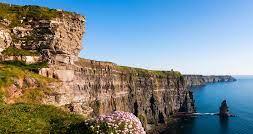
30 CAP AKWG
Terrain features can be learned using the fist or hand to show what each would look like on the ground.
LET’S P CTICE IT

CAP AKWG 31
Do you know what 5W is?
Creating a project is not an easy task, especially when this action plan involves many people, activities, deadlines, and high value. To make it easier to manage and describe all the items required in the plan, the 5W method adds more ease as there are specific fields for each definition.
What are the five W's of journalism?
Who, what, when where, why.
To write a clear article or deliver a strong presentation, ask and answer these five questions along with "how and how much."
Check out these questions:


What? What will be done? action, steps, description
Why? Why will it be done? justification, reason
Where? Where will it be done? location
When? When will it be done? time, dates, deadlines
Who? Who is doing it? responsibility for action
How? How will it be done? method, process
How much? How much will it cost to make? cost or expenses involved
32 CAP AKWG
CONG TULATIONS
Wants to congratulate the following cadets who worked hard to get their promotion
Kenai Composite Squadron
C/AMN Jon Broussard received the Curry Award.
C/A1C Zion Henderson earned the Achievement 2
C/SSgt Thomas Martin earned the Wright Brothers
C/SSgt Laif Rothenberger earned the Wright Brothers
C/STSgt Jacob Ries earned the Achievement 4
C/MSgt Lane Hillyer earned the Achievement 8
C/CMSgt Luke Hillyer earned the Achievement 8
Cadet Bullet C/Amn
Cadet Shook C/SMSgt
Cadet Montoya C/ Amn
They all have been working very hard and are setting a good example.
Lt Col Maynard Perkins of Birchwood
Composite Squadron recently graduated from Safety College. The Alaska Wing Commander, Col McClure, visited our squadron on March 7 to congratulate Col Perkins on his accomplishment and to present him with a coin.

We want to congratulate cadet C/2Lt. Simeonoff, in his promotion.

CAP AKWG 33
JBER Arcturus Composite Squadron
MIRACLE ON BUFFALO PASS- A BOOK REVIEW
Rocky Mountain Airways Flight 217
by Capt Richard Dennis, PAO
This is the exceptional story of a fully loaded commuter airline that crashes in the high mountains of Colorado during a blizzard with nearly all surviving. On December 4th 1978 the Rocky Mountain Airways Flight 217 turned around on its regularly scheduled trip, Steamboat Springs to Denver, due to extreme weather. But is still forced down in high mountains at the 10,500ft level. That December night, aircraft controllers note radio signals from Flight 217 becoming garbled, weak and then they lose total contact. Shortly, a C-130 flying high over the weather received an emergency signal on 121.5. This was the newly established emergency location transmitter’s (ELT) signal. The result of newly passed federal legislation. With this radio signal, search and rescue personnel have a much better chance of locating a downed aircraft. Aircraft controllers reported to the Air Force Rescue Coordination Center (RCC) the apparent loss of Flight 217. RCC near immediately initiated the search and rescue protocol, with a call-out to the Civil Air Patrol (CAP) which mobilized immediately. While none knew exactly where Flight 217 had gone down, there were clues and hunches. Flights seldom go down in the flat-lands, with aircraft crashes mostly found in the mountains. This ELT signal pointed towards the mountains. Then searchers recalled a brief widespread power outage which had occurred earlier. That outage was very brief as electrical utility workers found a main-breaker had tripped and reset it fully restoring all power. Was it possible that Flight 217 had caused that electrical outage? Flight 217 had plowed into deep snow during that blizzard on Dec 4th. The wings were tore off the DeHavilland DHC-6 Twin Otter as it came to rest.

34 CAP AKWG
(Richard Dennis writes from Chistochina (CZO) at MP 32.7 on the Tok Cut-Off and
Somehow the fuselage remained largely in-tact. Some passengers were seriously injured while others not so much. Being up front, the pilots were in tough shape. One passenger growing up in the Boy Scouting program and an Eagle Scout was instrumental in moving passengers around to stabilize and to minimize further injury as best as was possible. Heavy snow coupled with high winds created blizzard like conditions which challenged the search and rescue efforts. Soon Search & Rescue drivers were having difficulty seeing the route, occasionally going off the roads. Regularly, the CAP convoy would stop to take new ELT readings. At best, most only got a general reading. But as they went on, the signals became stronger and stronger. Search and Rescuers knew that time was critical. CAP searchers noted their ELT direction finding equipment pointing towards Buffalo Pass. The deep soft snow made snowmobiles near useless, requiring snow cats. With blizzard conditions, they often needed to retrace their tracks and try a different route. Hours passed. As they reached the Pass, they stopped to get another ELT reading with the direction finding equipment. Crash survivors heard the snow cat and saw the equipment's lights. At this they joyously shouted, “We’re here, We’re here!” Then, “We love you”, “We’re saved.” This was approximately 10 hours after the accident.
Then followed the arduous, time-consuming task of removing the survivors. Nearly all were injured to some extent, some seriously. Two of the 22 lost their lives. One passenger had lost her life immediately and two days later the pilot died. The NTSB found the pilots had exercised reasonable judgment. Out of this came the new FAA requirement that pilots are required to have not just seat belts, but shoulder harnesses too.
The author, Harrison Jones writes this noteworthy story, MIRACLE ON BUFFALO PASS now more than forty years after this amazing accident and survival story has occurred. The book came out in 2017. It is apparent that he has interviewed all possible people who were involved; crew, passengers and search and rescue personal.
is the Public Affairs Officer for the 085th, Tok Composite Squadron, Civil Air Patrol).
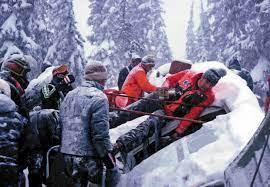
CAP AKWG 35
Support Alaska CAP Cadets through Pick.Click.Give.
Through Pick.Click.Give, Alaskans can choose to give a portion (or all) of their Permanent Fund Dividend (PFD) to charity. Thanks to generous donors from all over the state, Alaska Wing Civil Air Patrol Cadet Programs has used donations to support critical mission activities, including aerospace (and other STEM) education, emergency services, and cadet programs. When filling out your PFD application between now & March 31, please consider making a difference by contributing to the Alaska Wing Civil Air Patrol Cadet Programs (just “Search Organizaitons” for the name “Civil”)
Please forward this newsletter to your Alaskan neighbors, friends, co-workers, and family who may like to see what Civil Air Patrol does in Alaska and may like show their appreciation for the great work Civil Air Patrol does.

Helpful Links:
PFD Application Information: https://pfd.alaska.gov/
Pick.Click.Give General Information: https://www.pickclickgive.org/
Pick.Click.Give listing for Alaska Wing (AKWG) Civil Air Patrol (CAP) Cadet Programs: https://www.pickclickgive.org/index.cfm/pfdorgs.info/Civil-Air-Patrol-AKWG-CadetPrograms
36 CAP AKWG
Next Month Preview
Cadet Program Activities Photos Acknowledgments
Squadrons contacts
Communications
CAP Radios
Emergency Services
How to prepare a shelter
Public Affairs
How to prepare a Sketch
Aerospace education Teacher program

Education and Training
Diversity
Introduction to sign language
Next Activities
And More
CAP AKWG 37
Winter encampment is one of the highlights of the Alaska Wing as it connects Emergency Services and Cadet Programs to create a great training experience. It prepares many of the cadet participants for great learning experiences next summer, such as at Hawk Mountain Ranger School. Many thanks to the seniors, cadets and parents who worked hard to make it a success.
We are very fortunate to have Captain Julie Rivera on our Public Affairs team as she has done incredible work on this month's digital magazine! Wow, what a work of art she created for us here. Please help me congratulate her and welcome her to the Wing.

This online publication is designed to attract, inform and motivate readers through photos, text and stories. We see and feel the four core values in the faces and body language of the cadets and senior members portrayed herein. If you would like to propose any content by the 10th of each month or provide feedback then please contact me.

Volunteers serving America’s communities, saving lives, and shaping futures.
Lt Col Bryan Emerson, CAP Publisher and Editor
Alaska Wing PAO, DC
Bryan.EmErson@akwg.cap.gov
1 (907) 795-5586 cell
Co-Editor
Alaska Wing PAO Assistant
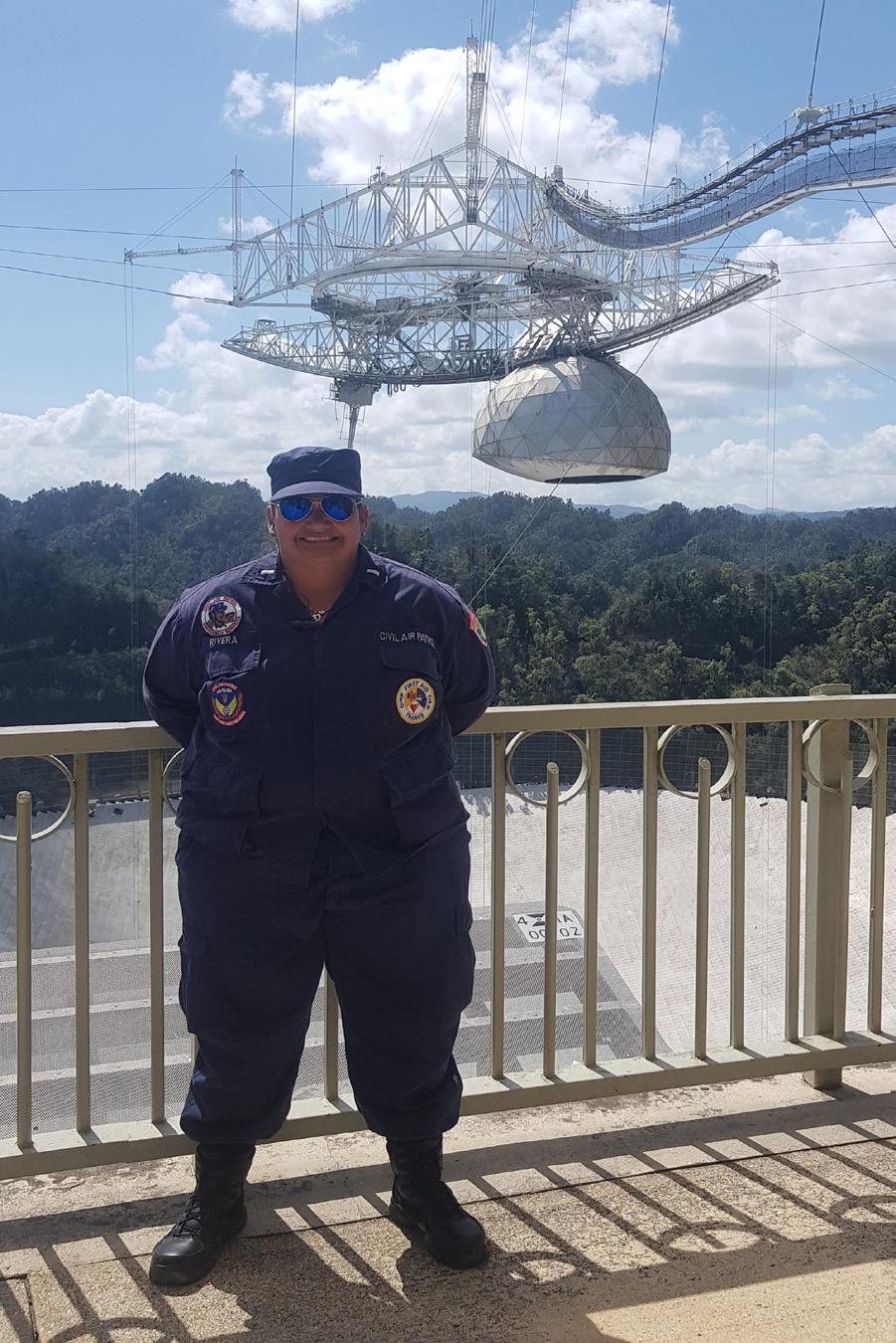
617596@akwg.cap.gov
1 (787)424-0560
38 CAP AKWG
Capt. Julie G. Rivera CAP



















































































